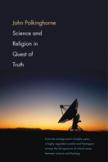The Open Source Universe
In the search for truth and understanding in today’s world there is arguably no more important interaction than that between the natural sciences and religious belief. From academe to journalism, from Beijing to Boston the interplay between these two prominent areas of modern culture rings out with a clarion call to either dialogue or warfare. There are very few, to my mind, who have spoken out with as nuanced and balanced an approach to this interaction as John Polkinghorne, a physicist, Anglican priest and firm proponent of the ultimate unity of all the best of our experiences as human beings.
In this book Polkinghorne has gathered together his thinking over several decades. He reflects once more on topics, presented especially in 15 of his books, which cover a vast range of areas in which he sees the most meaningful threads weaving together a multicolored fabric of religious faith and scientific knowledge. His approach is both serious and playful. When exploring, for instance, the classical concept of the human soul in terms of modern ideas on information-bearing patterns he states: “We are playing with the toys of thought, but it is play with serious intention.”
The overarching epistemology of this book, as of all his writings on these matters, is to pursue theology in the context of science. Thus the “bottom-up” approach—from empirical evidence to understanding—which is the hallmark of the sciences is also for Polkinghorne an essential, if not exclusive, characteristic of theology. On the other hand, the scientific venture requires a faith—only analogous to religious faith—that there is a rational structure to the universe that science explores. Both science and religion are seeking truth through the attainment of well-motivated beliefs. In both searches the seeker after truth proceeds by reasonable, motivated faith and not by certain insight.
Although Polkinghorne admits that the ultimate interpretation of quantum mechanical uncertainty cannot be resolved by physics alone, he offers convincing arguments that in the quantum world there is an intrinsic, ontological uncertainty and that even at the macroscopic level, this characterizes a world that has an open and not totally predetermined future. This intrinsic openness of reality is further reinforced by the examination of so-called “chaotic” macroscopic systems, in which the initial conditions of certain dynamical systems are sufficiently undetermined that the future history of the system cannot be fully calculated. In brief, the universe as known from physics has an intrinsic, dynamic, open character to it, and thus it is creative. In brief, the universe as a totality is relational and evolutionary.
While in the tradition of Darwin many would reserve the notion of evolution to living systems, Polkinghorne presents cogent arguments for predicating evolution of the universe as a whole. From quantum to macroscopic processes, the universe continues to evolve and not simply to complete a predetermined design. While Darwinian natural selection can only be properly predicated of living systems, it is not, according to Polkinghorne, of the essence of evolution as such. Is it not proper to see evolution at work in the birth of galaxies and stars, where chance and necessity are at work? The science of cosmology has shown that small, random fluctuations in the primeval energy/matter of the universe provided the seeds from which gravity—a law of nature— brought about the birth of galaxies and stars. This came about not by pure chance nor by pure design but by a blending of random processes intertwined with the lawful structure of the universe. This is evolution on a grand scale.
This is but one of the many instances in which Polkinghorne now invites us to consider that the rational structure of the world as seen by science is “shot through with signs of mind, and religious belief suggests that it is indeed the mind of the Creator that lies behind the wonderful order of the universe.” Other similar invitations are offered by Polkinghorne’s discussion of quantum mechanics and quantum cosmology, information theory, the nature of time, consciousness and personality, etc. But the author reminds us time and time again that “such hints of God will not arise from mistaken attempts to provide theological answers to scientific questions, for we have very good reason to believe that scientifically stateable questions will receive scientifically stateable answers without the need for assistance from theology.” This book is an elegant and persuasive argument that accepting the hints can be a deeply rewarding human, perhaps even spiritual, experience.
This article also appeared in print, under the headline “The Open Source Universe,” in the June 4, 2012, issue.








